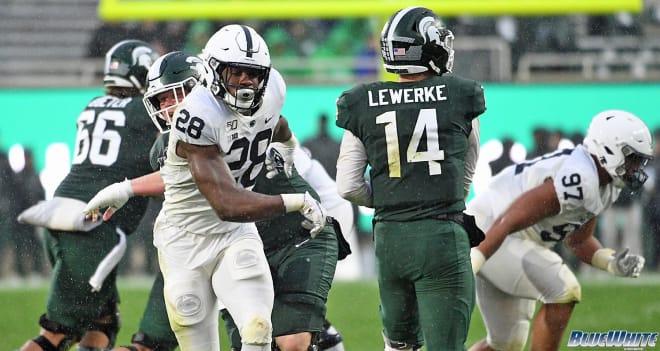Opting out: The pros and cons of sitting out an unconventional season
As Penn State fans well know, opt outs are becoming part of college football's new reality.
Before the Big Ten presidents voted to postpone the fall season, star linebacker Micah Parsons announced he wouldn't be playing. Among the schools that still plan to play, countless players have chosen not to participate.
There have been various reports about how the Big Ten plans to handle its postponed season, with some suggesting a late fall season may be in the cards, while others have reported winter and spring seasons are the likeliest of the options.
Regardless, the season will be unconventional, presenting new health and injury risks to players who have NFL futures at stake.
Should the Big Ten opt for a return to play, BWI explored specific pros and cons relating to each player who might opt to sit out the season in favor of an NFL future, starting on Thursday, with the offense. Now, let's get to the defense.

Shane Simmons — Redshirt Senior Defensive End
Pros:
Injury risk — While the congestion that might occur if the Big Ten chooses to play its season in the winter or spring will make injuries a greater concern for just about everyone, it might justify even more consideration for a guy like Simmons, who has unfortunately missed several games due to injury over the course of his Penn State career.
Playing time — Simmons was listed as a backup at one of the defensive end spots behind Jayson Oweh on Penn State's spring depth chart, and without the promise of significant playing time, it might make sense for him not to risk playing in an unconventional campaign.
Cons:
Upside — Simmons had a promising redshirt freshman year in which he compiled 13 total quarterback pressures and a sack. He hasn't registered a sack since, and has 10 quarterback pressures combined in the two seasons since. Returning to the form he showed as an underclassman, and proving he could remain injury free, would do wonders for his stock.
Shaka Toney — Redshirt Senior Defensive End
Pros:
Proven production — In his first year as a full-time starter, Toney finished just outside the top-10 in the Big Ten with 6.5 tacks. He tallied 43 total pressures, good for 10th in the conference and five more than his teammate, Yetur Gross-Matos, who went in the second round of this spring's NFL draft.
Well-roundedness — Toney was hardly a pass-rush specialist last season. Penn State trusted him in several run stopping situations throughout the year, and PFF graded him as the 12th-best run stopper among Big Ten defensive ends who took 50 percent or more of their team's snaps. He could be enticing as a well-rounded option for NFL teams.
Cons:
Size — Toney's difficult path to weight gain at Penn State has been well documented. A devout Muslim, fasting for a month during Ramadan every year has presented a unique challenge to Toney's ability to bulk up. He came to Penn State below 200 pounds and is now all the way up to 231 pounds. Despite that progress, he would still be considered small for an NFL defensive end, and another season to add weight might benefit him.
Experience — Last season was Toney's first with more than 350 total snaps, and while it was a productive season, it's possible that another year of experience would lead to even more production and allow him to raise his stock even more.
Antonio Shelton — Redshirt Senior Defensive Tackle
Pros:
Size — At 6-foot-2, 310 pounds, there would be little concern about Shelton's ability to compete physically with NFL offensive linemen.
Degree — Shelton completed his degree in broadcast journalism last December.
Cons:
Experience — Despite starting 12 games for the Nittany Lions last year, Shelton only played 376 snaps, and has only taken 673 snaps when accounting for the whole of his Penn State career.
Tariq Castro-Fields — Senior cornerback
Pros:
Been there, done that — Castro-Fields was an immediate contributor from the moment he stepped on campus, earning the green light to play as a true freshman. He's got over 1,400 snaps under his belt as a college player, and will have plenty of tape to show NFL scouts.
Physicality — Scouts will likely see something they can build on in Castro-Fields. He's big for a corner at 6-foot, 195 pounds, and has proven that he can use that frame. His 22 defensive stops — defined as tackles that result in a failed outcome for the offense — were tied for fifth among Big Ten corners last season.
Cons:
Recency bias — Castro-Fields struggled down the stretch of the 2019 season. From Week 7 onward, he was targeted 40 times and allowed 25 receptions while also missing 8 tackles. In the whole of the 2018 season, he was targeted 45 times, allowing 20 receptions and missing 8 tackles. Another season might help Castro-Fields prove he's better than his most recent form shows.
Jaquan Brisker — Senior Safety
Pros:
Playmaking — Brisker played in a reserve role for the Nittany Lions upon transferring from Lackawanna College, and as a result saw only 470 snaps last season. Despite that, he was one of only 10 Big Ten safeties to record two or more interceptions last season, while also forcing a fumble.
Cons:
Experience — As mentioned above, Brisker simply hasn't played very much at the Division I level, and it's possible NFL scouts will want to see more from him before they risk drafting or signing him.
Upside — Brisker figures to fit more prominently into Penn State's plans if and when this season gets underway. The spring depth chart slated him as one of the starting safeties alongside Lamont Wade, meaning he should get the snaps he needs to raise his stock come draft day if he sticks around.
Lamont Wade — Senior Safety
Pros:
Explosiveness — Like Brisker, Wade proved himself a playmaker last season. He collected two sacks among eight quarterback pressures last season, along with three forced fumbles. Pro Football Focus gave him the third best run defending rating among Big Ten safeties, behind Antoine Brooks Jr. and teammate Garrett Taylor. That will surely be a means for him to make his NFL case.
Cons:
Positional development — Wade was moved from cornerback to safety before the 2018 season, and while he has settled into the role nicely, one could argue that another season in blue and white would serve him well as he looks toward an NFL future.
Coverage metrics — No safety who took more than 20 percent of his team's snaps was targeted more than Wade last year. He allowed 30 receptions on 56 total targets for 290 years and two touchdowns — something NFL teams may want to see him improve with another year as a college safety under his belt.
Ellis Brooks — Redshirt Junior Linebacker
Pros
Size — There's no need for concern about filling out for Brooks, who at 6-foot-1, 241 pounds, has a body that can compete at the NFL level.
Pass rushing — Even from an inside linebacker spot, Brooks was excellent at getting after the quarterback last season. He notched three sacks, good enough to tie him for 10th in the Big Ten among linebackers. He did that in only 292 snaps, while eight of the nine players ahead of him had at least 550 snaps to accumulate their total.
Cons:
Upside — Brooks has played a role for Penn State in each of the last two seasons, but has still yet to find his way into one of the starting linebacker spots for Penn State, which would led to an uptick in reps that would give him a chance to better showcase his game and grow his stock.
Experience — In a similar vein, Brooks just hasn't played enough for NFL teams to know for sure what they're getting, which Brooks may see as a reason to return for the 2020 season.
P.J. Mustipher — Junior Defensive Tackle
Pros:
Size — Mustipher's 6-foot-4, 308 pound frame would give him a chance physically against NFL offensive lines.
Cons:
Experience — Mustipher simply hasn't played very much since arriving at Penn State. He's managed to make an impact as a substitute off the bench, but it's possible NFL teams still won't be clear on what he can bring to the table.
Upside — Mustipher held one of the starting defensive tackle spots on Penn State's spring depth chart, so it seems likely that he would get a chance at extended reps in order to potentially grow his stock.
Jayson Oweh — Redshirt Sophomore Defensive End
Pros:
Stock — The mock drafts and projections love Oweh. Outside of Micah Parsons, who has already opted out, and Pat Freiermuth, Oweh is the Penn State player most commonly mentioned by the early mock drafts. Despite note having played much, there might be something at risk for him should he choose to take part in the season.
(Editor's note: At present, Oweh's status with the program has not changed as he remains listed on Penn State's official roster - unlike Micah Parsons and Brandon Taylor - even though he has made social media posts of himself working out recently with Parsons in California.)
Athleticism — Oweh is a physical freak, even at 6-foot-5 and 253 pounds. His 40-yard dash time was the third best on the team as of this spring, at 4.33 seconds, behind only Journey Brown and Drew Hartlaub.
Cons:
Late bloomer — Oweh didn't pick up the game of football until his junior year of high school. Knowing that, it's possible NFL teams will prefer to see another season from him at Penn State before using a draft pick on him.
College experience — Behind two strong defensive ends in Yetur Gross-Matos and Shaka Toney last season, Oweh didn't see the field much. He took just 332 snaps, but still managed to come up with five sacks.
Upside — With all the physical gifts Oweh has, he may feel that another season at Penn State will allow him to burst on the scene and allow his stock to rise even higher than it already is.
*******
• Talk about this article inside The Lions Den
• Watch our videos and subscribe to our YouTube channel
• Learn more about our print and digital publication, Blue-White Illustrated
• Follow us on Twitter: @BWIonRivals, @NateBauerBWI, @RivalsSnyder, @DavidEckert98
• Like us on Facebook
